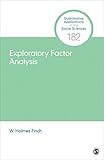Exploratory factor analysis / W. Holmes Finch, Ball State University.
Material type: TextPublication details: Los Anageles SAGE 2020Description: x, 125 pagesISBN:
TextPublication details: Los Anageles SAGE 2020Description: x, 125 pagesISBN: - 9781544339887
- 300.721 FIN
| Item type | Current library | Collection | Call number | Status | Date due | Barcode | |
|---|---|---|---|---|---|---|---|
 Books
Books
|
Prof. Ram Dayal Munda Central Library | Sociology | 300.721 FIN (Browse shelf(Opens below)) | Available | 77547 |
Includes bibliographical references (pages 111-117) and index.
"Understanding factor analysis is key to understanding much published research in the social and behavioral sciences. This volume provides a solid foundation in exploratory factor analysis (EFA), which along with confirmatory factor analysis, represents one of the two major strands in this field. The book lays out the mathematical foundations of EFA; explores the range of methods for extracting the initial factor structure; explains factor rotation; and outlines the methods for determining the number of factors to retain in EFA. The concluding chapter addresses a number of other issues in EFA such determining the appropriate sample size and handling missing data, and it offers brief introductions to EFA with structural equation modeling and multilevel models for EFA. Example computer code, and the annotated output for all of the examples included in the text are available on an accompanying website"--
There are no comments on this title.
